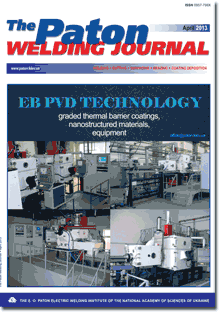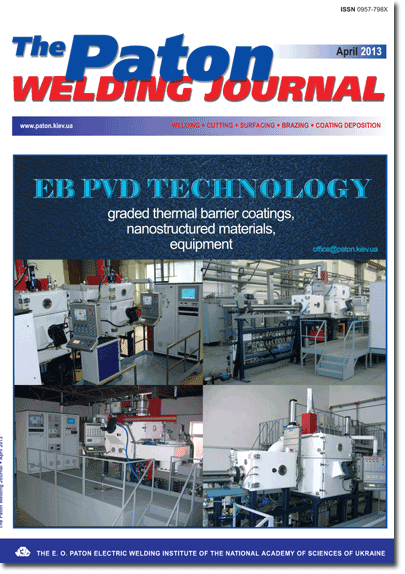| 2013 №04 (11) | 2013 №04 (01) |

TPWJ, 2013, #4, 61-63 pages
INFLUENCE OF TECHNOLOGICAL SCHEMATICS OF INDUCTION SURFACING ON STABILITY OF DEPOSITED LAYER THICKNESS
Journal The Paton Welding Journal
Publisher International Association «Welding»
ISSN 0957-798X (print)
Issue № 4, 2013 (April)
Pages 61-63
nbsp;
nbsp;
Authors
Ch.V. PULKA, V.S. SENCHISHIN, V.Ya. GAVRILYUK and M.S. BAZAR
Ternopol Ivan Puluj National Technical University, Ternopol, Ukraine
nbsp;
Abstract
Induction surfacing is applied in manufacture and repair of cutting tools of agricultural machinery. Deposited layers improve the tool wear resistance. Here it is important to take into account the deposited layer thickness. The paper presents the results of investigation of geometrical characteristics of a layer of metal deposited by induction process with wear-resistant powder-like consumables by four technological schematics. It is shown that application of shields, horizontal vibration and rotation of the surfaced part improves the stability of geometrical characteristics of the deposited metal layer by 22 %, compared to traditional induction surfacing. A procedure was developed for measurement of geometrical characteristics of the metal layer deposited by induction process, which allows increasing the measurement accuracy, as well as monitoring the stability of layer thickness at development of new technological processes of induction surfacing of thin flat parts. 8 Ref., 3 Figures.
Keywords: induction surfacing, inductor, surfacing modes, thermal and electromagnetic shields, deposited layer thickness, rotation, horizontal vibration
Received: 30.01.13
Published: 28.04.13
References
1. Ryabtsev, I.A. (2004) Surfacing of parts of machines and mechanisms. Kiev: Ekotekhnologiya.
2. Senchishin, V.S., Pulka, Ch.V. (2012) Modern methods of surfacing the tools of agricultural tillers and harvesting (Review). The Paton Welding J., 9, 43-49.
3. Pulka, Ch.V. (2006) Technological and energy efficiency of induction surfacing of thin steel disks: Thesis of Dr. of Eng. Sci. Kiev.
4. Bol, A.A. (1984) Development of induction surfacing in agricultural machinery engineering. Tekhnologiya, Issue 3, 38.
5. Pulka, Ch.V., Shably, O.N., Senchishin V.S. et al. (2012) Influence of vibration of parts in surfacing on structure and properties of metal. The Paton Welding J., 1, 23-25.
6. Pulka, Ch.V., Gavrilyuk, V.Ya., Senchishin, V.S. (2013) Improvement of equipment and technology of induction surfacing. Svarochn. Proizvodstvo (in the press).
7. Kolker, Ya.D. (1976) Mathematical analysis of the accuracy of part machining. Kiev: Tekhnika.
8. Barabashchuk, V.I., Kredentser, B.P., Miroshnichenko, V.I. (1984) Experiment planning in engineering. Kiev: Tekhnika.
The cost of subscription/purchase order journals or individual articles
| Journal/Currency | Annual Set | 1 issue printed |
1 issue |
one article |
| TPWJ/USD | 384 $ | 32 $ | 26 $ | 13 $ |
| TPWJ/EUR | 348 € | 29 € | 24 € | 12 € |
| TPWJ/UAH | 7200 UAH | 600 UAH | 600 UAH | 280 UAH |
| AS/UAH | 1800 UAH | 300 UAH | 300 UAH | 150 UAH |
| AS/USD | 192 $ | 32 $ | 26 $ | 13 $ |
| AS/EUR | 180 € | 30 € | 25 € | 12 € |
| SEM/UAH | 1200 UAH | 300 UAH | 300 UAH | 150 UAH |
| SEM/USD | 128 $ | 32 $ | 26 $ | 13 $ |
| SEM/EUR | 120 € | 30 € | 25 € | 12 € |
| TDNK/UAH | 1200 UAH | 300 UAH | 300 UAH | 150 UAH |
| TDNK/USD | 128 $ | 32 $ | 26 $ | 13 $ |
| TDNK/EUR | 120 € | 30 € | 25 € | 15 € |
AS = «Automatic Welding» - 6 issues per year;
TPWJ = «PATON WELDING JOURNAL» - 12 issues per year;
SEM = «Electrometallurgy Today» - 4 issues per year;
TDNK = «Technical Diagnostics and Non-Destructive Testing» - 4 issues per year.


